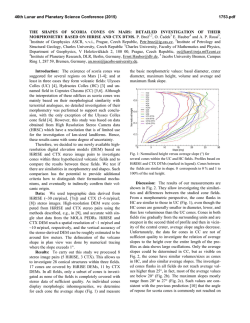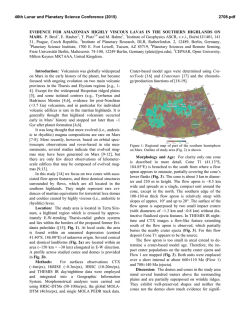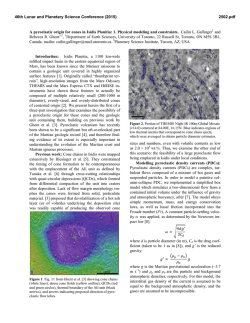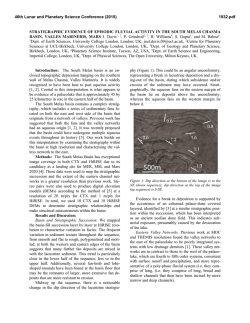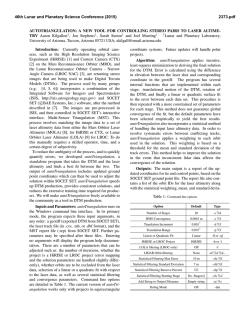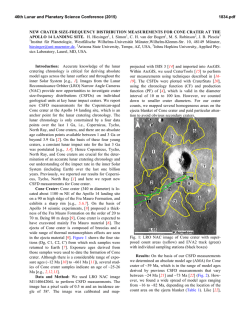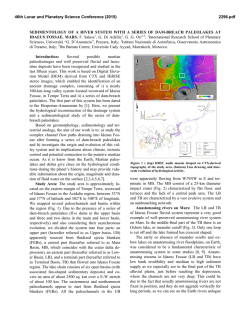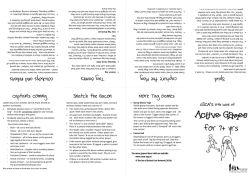
A Field of Small Pitted Cones on the Floor of Coprates Chasma, Mars
46th Lunar and Planetary Science Conference (2015) 1476.pdf A FIELD OF SMALL PITTED CONES ON THE FLOOR OF COPRATES CHASMA MARS: VOLCANISM INSIDE VALLES MARINERIS? E. Hauber1 , P. Brož2,3, A.P. Rossi4, G. Michael5, 1Institute of Planetary Research, DLR, Berlin, Germany, [email protected], 2Institute of Geophysics ASCR, v.v.i., Prague, Czech Republic, 3Institute of Petrology and Structural Geology, Charles University, Prague, Czech Republic, 4Jacobs University, Bremen, Germany, 5Institut für Geologische Wissenschaften, Freie Universität Berlin, Germany. Summary: We present observations of a field of >100 pitted cones and mounds situated on the floor of Coprates Chasma (part of Valles Marineris (VM); Fig. 1), which display similarities to terrestrial and martian scoria cones. If these cones are indeed volcanic in origin, they will significantly expand our knowledge about the morphometry of pyroclastic cones on Mars. Moreover, a magmatic origin, which would necessarily post-date the opening of the main VM troughs, would contribute to our understanding of the volcano-tectonic evolution of VM. Figure 1: Location of investigated cones (triangles) and mounds (dark circles) in eastern Coprates Chasma (CTX mosaic). The edifices are spread over the entire trough. Background and Motivation: It has long been suggested that volcanism played a role in the formation of Valles Marineris [e.g., 1], but unambiguous evidence has been rare. Recent images acquired by the CTX camera (~5-6 m/px) reveal the existence of several fields of small pitted cones, mainly associated with chaotic terrain in the eastern part of VM [2,3] and also in Coprates Chasma [3,4]. Coprates Chasma is a linear graben extending in west-east direction for ~1000 km. It probably formed as one of the most recent main depressions of the VM system. Based on morphological similarities, Harrison [3] suggested that these cones might represent scoria cones, but without providing further details. Meanwhile the whole area is covered by CTX images that enable analysis of the entire cone field. One cluster of pitted cones is covered by a HiRISE stereo pair, allowing the production of a HiRISE Digital Elevation Model (DEM). Based on these new data, we studied the cones in unprecedented detail. Here we show preliminary results. Data and Methods: We used images from CTX, HRSC, and HiRISE. Topographic information is derived from single MOLA shots, HRSC DEMs, and HiRISE and CTX DEMs that were computed using the methods described in [5]. HRSC, CTX, and HiRISE DEMs have a grid spacing of~50-100 m/px, ~10 m/px, and ~1 m/pixel, respectively. Observations: The cones and mounds are widely spread over a total area of about 155 × 35 km. Some cones stand alone, others are concentrated in clusters with up to ten edifices (Fig. 2). In plan view, their morphology is characterized by circular to elongated shapes. Their flanks have slopes up to 25°, but are generally more shallow. Cone basal diameters vary from 0.5 km up to 2.2 km, with a mean of 1 km (based on 23 cones). Most of them have summit craters (Fig. 2a), which have diameters from 0.15 km up to 0.8 km (mean 0.3 km). In some cases craters are superposed by other craters suggesting the lateral migration of explosion sites or feeder dikes. Typically, the cones are not breached, but there are two exceptions which seem to result from explosion and/or collapse of the cone. In some cases cones are superposed on units with a rough texture that forms local bulges (Fig. 2b,c). To compare the cones morphologically with martian and terrestrial analogues, we measured the basal diameters of the cones (WCO) and the crater diameters (WCR). The WCR/WCO ratio ranges between 0.22 and 0.5, with an average of 0.34. Fresh terrestrial and Martian scoria cones have ratios of ~0.4 [6], and ~0.27 [7], respectively. The cones appear relatively pristine, and small impact craters do not change their shapes significantly. Discussion and Conclusions: The studied cones bear many morphological similarities to edifices in Hydraotes Chaos [2] and Ulysses Colles [7] that were previously interpreted as scoria cones. The Coprates cones are smaller (WCO on average 1 km) than the Hydraotes cones (1.5 km) and the Ulysses cones (2.3 km), but with similar WCR/WCO ratios (0.34 for cones in Coprates and 0.27 for cones in Ulysses). This might be caused by a higher atmospheric pressure at the floor of Coprates Chasma (~5 km beneath Mars’ global datum) disabling a wider dispersion of ejected particles from the vent [8], by a smaller amount of erupted material or by smaller erosion. The associated elevated rough units around the edifices are similar to what is observed in Hydraotes Chaos and Ulysses Colles. Similar rough 46th Lunar and Planetary Science Conference (2015) 1476.pdf Figure 2: Three clusters of cones and mounds in Coprates Chasma. Note the rough elevated units on which the edifices are superposed. We interpret them as lava flows and/or pyroclastic deposits. (a) HiRISE ESP 034131 1670, centered 12.73°S, 62.8°W (b) CTX image G20_026061_1675, 13.28°S, 60.89°W (c) CTX image B22_018268_1659, 12.71°S, 62.38°W. textures around terrestrial scoria cones are associated with lava flows and possibly pyroclastic deposits. At HiRISE resolution, further details provide possible hints to the nature of the cones. Where scarps break the surface of the otherwise smooth-textured cones, series of fine parallel layers are visible in some places (Fig. 3 a and d, b and e). Although other interpretations are possible, this would be consistent with an volcanic origin of some cones, specifically as phreatomagmatic edifices, e.g., tuff cones. In another location, the surface texture adjacent to a cone is reminiscent of that of a lava flow surface (Fig. 3 c and f). The spatial distribution of cones (2 point-azimuth analysis; for details see ref [9]) reveals two main trends of a possible structural control. One is oriented parallel to the main VM trend (~N110°), while another is ~N75° (Fig. 4). The first trend suggests that magma feeding the cones may have ascended (as dikes?) along weakness zones created by VM formation. Our preliminary results, therefore, support previous suggestions [4,5] that this field is probable volcanic in origin and consists primarily of scoria cones. If so, this field in Coprates Chasma may be among the largest known fields of scoria cones on Mars. Ongoing inves- tigations will help to extend our knowledge on scoria cone formation on Mars and will also help to provide further insight about the evolution of Valles Marineris. Figure 4: Results of 2-point azimuth analysis. (top left) Histogram of distances between vents. (bottom left) Map of cone positions and distribution of connecting lines with a length smaller than the minimum significant distance. (right) Rose diagram of trend analysis, black bars show main trends. References:. [1] Lucchitta, B.K. (1987) Science, 235, 565-567. [2] Meresse, S. et al. (2008) Icarus, 194, 487–500. [3] Harrison, T.N. (2012) LPSC, XLIII, Abstract #1057. [4] Harrison, K.P. and Chapman, M.G. (2008) Icarus, 198, 351–364. [5] Moratto, Z.M. et al. (2010) LPSC, XLI, Abstract #2364. [6] Wood, C.A. (1980) J. Volcanol. Geotherm. Res., 7, 387–413. [7] Brož, P. and Hauber, E. (2012) Icarus, 218, 1, 88–99. [8] Brož, P. et al. (2014) Earth Planet. Sci. Lett., 406, 14-23. [9] Brož, P. and Hauber, E. (2013) JGR-Planets, 118, 1656-1675. Figure 3: Details of cone morphology (HiRISE). (a) ESP_033986_1670, 12.73°S/297.2°E. (b) ESP_036109_1675, 12.4°S/297.21°E. (c) ESP_036254_1665, 13.28°S/298.52°E. (d) Parallel, flat-lying layers exposed in inner crater wall. (e) Similar fine layering in scarp of eroded cone. (f) Exhumed (?) surface with lobate margins adjacent to cone, reminiscent of a lava flow surface texture.
© Copyright 2025
